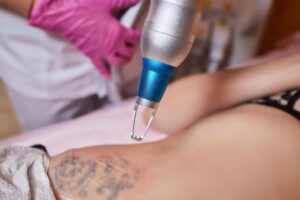
As society evolves, so do personal styles and preferences. Tattoos, once considered a permanent statement, are now often seen as symbols of past moments that individuals may wish to erase. For those situated in Leeds, laser tattoo removal offers a solution to reclaiming the skin and moving forward without the ink of the past.
This article delves into the intricacies of the laser tattoo removal process, the technology behind it, and what individuals can expect when opting for such treatments in Leeds.
Understanding Laser Tattoo Removal
Laser tattoo removal is a medical procedure that employs concentrated beams of light to break down the ink particles embedded in the skin. The most commonly used lasers for this procedure are Q-switched lasers, which emit short pulses of high-intensity light. Tattoos consist of various ink colors, and different wavelengths of light are required to effectively target these colors. The laser energy is absorbed by the ink, causing it to fragment into smaller particles that can be naturally eliminated by the body’s immune system.
The procedure is non-invasive, making it a preferred choice for those looking to remove unwanted tattoos. Patients are typically advised to avoid sun exposure on the tattooed area before and after treatment to ensure optimal results. Additionally, the skin’s healing process plays a crucial role in the effectiveness of tattoo removal; thus, multiple sessions are often necessary to achieve the desired results.
The Process of Laser Tattoo Removal
The journey of laser tattoo removal starts with a consultation, where a trained professional evaluates the tattoo and discusses the removal process with the patient. During the consultation, factors such as the tattoo’s size, color, and location are assessed to determine the most effective treatment plan. It is essential for patients to communicate their expectations and any concerns they may have, ensuring a tailored approach to their needs.
Once the treatment plan is established, the actual procedure begins. Patients are typically given protective eyewear, and a topical anesthetic may be applied to minimize discomfort. The technician then uses a handheld laser device to target the tattoo. The sensation during treatment can be likened to the snapping of a rubber band against the skin, varying in intensity depending on individual pain tolerance and the tattoo’s characteristics.
After the treatment session, the skin may exhibit redness, swelling, or a slight blistering effect, which is a normal reaction. Proper aftercare is crucial; patients are advised to keep the treated area clean and avoid exposing it to direct sunlight. Over the following weeks, the body naturally begins to break down the ink particles, gradually fading the tattoo.
What to Expect After Treatment
Post-treatment care is vital for successful laser tattoo removal. Patients should expect some initial discomfort, similar to a mild sunburn, which typically subsides within a few days. It is essential to avoid picking at any scabs or blisters that may form, as this can lead to scarring or infection. Most practitioners will provide specific aftercare instructions, which may include applying a soothing ointment and keeping the area covered.
In the weeks following the procedure, patients will notice the tattoo gradually fading. It is important to understand that multiple sessions are usually required for complete removal, especially for larger tattoos or those with vibrant colors. Each session is spaced several weeks apart to allow the skin to heal and the body to process the ink particles effectively.
Choosing a Provider for Laser Tattoo Removal in Leeds
Selecting the right clinic for laser tattoo removal is a critical step in ensuring safety and effectiveness. Patients should look for clinics that prioritize professionalism and have a solid track record in performing laser treatments. It is advisable to read reviews, ask for before-and-after photos, and ensure that the staff members are qualified and experienced in the field.
In Leeds, numerous clinics offer laser tattoo removal, each with its unique approach and technology. Patients should prioritize clinics that invest in the latest laser technology, as advancements in this area can significantly enhance the efficacy of treatments while minimizing discomfort. Additionally, transparency about the process and expected results is essential for building trust between the patient and the provider.
Conclusion
In conclusion, laser tattoo removal in Leeds presents a viable option for individuals looking to erase past ink and start anew. This non-invasive procedure utilizes advanced laser technology to break down tattoo ink, allowing the body to naturally eliminate it over time. Understanding the process, from the initial consultation through to post-treatment care, is essential for achieving the best results.
Patients are encouraged to research and choose a reputable clinic that prioritizes patient safety and satisfaction. Este Medical Group stands out as a trusted provider in this field, offering expert care and state-of-the-art technology to facilitate the journey towards clearer skin. For those ready to take the first step towards tattoo removal, booking a consultation with Este Medical Group can provide the guidance and support needed to embark on this transformative experience.

